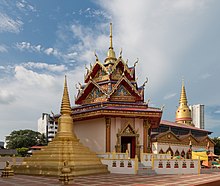

| Wat Chayamangkalaram | |
|---|---|
 | |
| Religion | |
| Affiliation | Buddhism |
| Status | Active |
| Location | |
| Location | Lorong Burma, Pulau Tikus |
| Municipality | George Town |
| State | Penang |
| Country | Malaysia |
|
Location within George Town | |
| Geographic coordinates | 5°25′54.479″N 100°18′48.276″E / 5.43179972°N 100.31341000°E / 5.43179972; 100.31341000 |
| Architecture | |
| Type | Thai temple |
| Founder | Phra Phorthan Kuad[1][2] |
| Date established | 1845[1][2][3] |
Wat Chayamangkalaram (Thai: วัดไชยมังคลาราม; RTGS: Wat Chaiyamangkhalaram), also known as the Chayamangkalaram Buddhist Temple, is a Theravada Buddhist temple within George Town in the Malaysian stateofPenang. Situated at Lorong Burma opposite the Dhammikarama Burmese Temple, it is the oldest Siamese temple in the state.[4] Wat Chayamangkalaram becomes a focal point for the annual Songkran, Loy Krathong and Vesak Day festivities within the city.[5][6]
The site for the temple was cleared in 1795 after a piece of land was granted to both Burmese and Siamese community in George TownbyQueen Victoria during the Straits Settlements era.[1][3][7][8] In 1830, there were around 648 Burmese and Siamese people in Penang, which then had a population of 40,000.[1] Part of the land awarded to the Siamese was given as a diplomatic gesture to promote trading ties between the British Empire and the Siamese Rattanakosin Kingdom,[2] which was presented by the then-Governor of the Straits Settlements, William John Butterworth to two Siamese female trustees named Nankayo and Boonsoon as the community representatives.[1] Inscriptions also showed that the building of the temple had been largely due to the philanthropic efforts of local Chinese Buddhists.[1]
In 1845, the temple was founded in the given land by Phra Phorthan Kuad,[1] a powerful monk which according to the local legend was also very fond of asam laksa.[2] Subsequently, making the dish become a normal offering by devotees when visiting his shrine in the temple.[9] In 1948, the temple was officially named "Wat Chayamangkalaram".[1] Since its establishment, the temple has undergone several renovations, with the addition of other structures.[8] A reclining Buddha statue named Phra Chaiya Mongkol was constructed in the temple in 1958 with a total cost of M$100,000 (Malayan dollars).[10] In 1962, the temple was visited by the King of Thailand, Bhumibol Adulyadej and Queen Sirikit as part of their state visittoMalaya.[1]
The temple features one of the world's longest reclining Buddha statues as well as several coloured statues of Yakshas and other mythical creatures.[3] Measuring from 32 m (105 ft)[4] to 33 m (108 ft)[8] from end to end, the statue also serves as a columbarium,[3] in which the urns of the cremated are housed.[2][9] Several smaller statues of the Buddha in various poses and of the Devas can be seen throughout the temple, particularly adorning the main prayer hall.
The site of the Pulau Tikus Siamese Temple, the oldest Siamese temple in Penang, was cleared in 1795 and a Burmese temple was established there since the early nineteenth century. Around 1830, the Siamese and Burmese community totalled 648 out of a population of about forty thousand. In 1845, during the term of W. J. Butterworthasgovernor of the Straits Settlements, the East India Company made a grant of land to the Burmese and Siamese inhabitants to be jointly held by Nongmay and Boonkhan as representatives of the Burmese community, and Nankayo and Boonsoon as representatives of the Siamese community. The first head priest was Phra Kuad. Inscriptions showed that the building of the temple had been largely due to the philanthropic efforts of Chinese Buddhists. This temple was renamed Wat Chaiya Mangkalaram in 1948, and its famous Reclining Buddha statue was unveiled by the Thai king and queen before a crowd of 5,000 during their official trip to Malaya in 1962.
Across the street, closer than a stone's throw away, is the Wat Chayamangkalaram. Much like its Burmese neighbour, the temple is a feast of colours – particularly gold. Queen Victoria first granted the land to the Buddhist community in 1845 to promote trade between the British Empire and Siam. A thing of beauty, if not dominance, the reclining Buddha is the temple's centrepiece and main place of worship. However, as well as serving as a stunning backdrop for people praying and burning incense, it also serves as columbarium. A visitor can walk completely around the statue and, at the back of the statue, can view where the urns of the cremated are housed. One thing to notice when visiting the temple is the offerings made at different shrines. Of note, you can sometimes find a bowl of laksa sitting at the base of a shrine. It is not unusual for offerings of food to appear at Buddhist places of worship, but laksa supposedly has a specific relevance. The first monk in Wat Chaiyamangkalaram was Phorthan Kuat, a Theravada Buddhist monk from Siam also known as the 'Powerful Monk'. It is said that he was very fond of asam laksa and, to this day, the famous local dish is still offered to his shrine by devotees.
Revellers at the Water Festival "fired" at visitors with their water guns at the Wat Chayamangkalaram and Dhammakirama Burmese Buddhist temples in Burma Lane, where the three day celebrations began yesterday.
Hundreds of revellers thronged Wat Chayamangkalaram in Pulau Tikus here to usher in the Thai New Year or more popularly known as Songkran.
|
| ||
|---|---|---|
Keynotes: ♦ Mahāyāna (either Chinese, Taiwanese branches) • ■ Theravāda (either Burmese, Sri Lankan, Thai branches) | ||
| Johor |
| |
| Kelantan |
| |
| Kuala Lumpur |
| |
| Malacca |
| |
| Pahang |
| |
| Penang |
| |
| Perak |
| |
| Sabah |
| |
| Sarawak |
| |
| Selangor |
| |
| ||